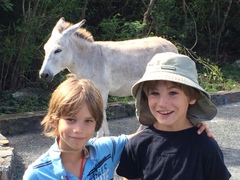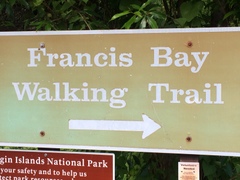 The boys and I need a change of pace (Matt has been terribly ill for days) so we decide to go on a hike rather than go swimming. We kayak to shore with the garbage, hats and a bottle of water. Part of the trail is a wooden boardwalk through a marshy area filled with thousands of small crabs, their large pincers sticking out of their holes. They all disappear when we get within four feet of them and pop back out once we move on.
The boys and I need a change of pace (Matt has been terribly ill for days) so we decide to go on a hike rather than go swimming. We kayak to shore with the garbage, hats and a bottle of water. Part of the trail is a wooden boardwalk through a marshy area filled with thousands of small crabs, their large pincers sticking out of their holes. They all disappear when we get within four feet of them and pop back out once we move on. 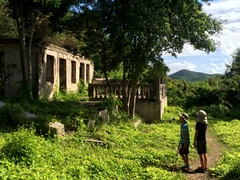 After a 20-minute walk, the boardwalk ends and turns into a dirt trail heading up the hill. We pass a large pond full of ducks and pink flowers. We continue following the trail and come upon the stone remains of an old plantation house. The boys are excited by every new development. The trail ends at a paved road, next to a tiny stone building engraved 1811. We walk down the road
After a 20-minute walk, the boardwalk ends and turns into a dirt trail heading up the hill. We pass a large pond full of ducks and pink flowers. We continue following the trail and come upon the stone remains of an old plantation house. The boys are excited by every new development. The trail ends at a paved road, next to a tiny stone building engraved 1811. We walk down the road 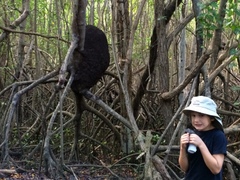 for ½ mile or so, seeing 3-foot insect nests in the trees and the poisonous Manchineel tree with its small fruit resembling apples (even standing under it in the rain is dangerous) and arrive at Leinster Bay.
for ½ mile or so, seeing 3-foot insect nests in the trees and the poisonous Manchineel tree with its small fruit resembling apples (even standing under it in the rain is dangerous) and arrive at Leinster Bay.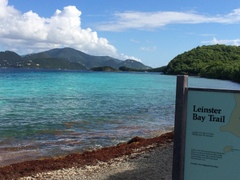 Across the road is the Annaberg Sugar Mill (a Danish slave plantation consisting of the ruins of a windmill, horse mill,
Across the road is the Annaberg Sugar Mill (a Danish slave plantation consisting of the ruins of a windmill, horse mill,
factory buildings and slave quarters). Sugar production, resulting in rum and molasses, was the mainstay of the island for 150 years. While there, we meet a local who seems to function as a gardener. He shows us an aloe vera plant and hibiscus and then says he’ll prepare us fresh coconut water. I tell him we hiked in and I have no money. He frowns, turns away and says, “Too bad.” We 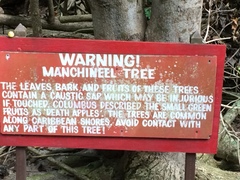 continue walking around and he calls us back. He shows us a fire pit where they burn wood to make charcoal and then slices open a fresh coconut and gives us half the meat. He also cuts
continue walking around and he calls us back. He shows us a fire pit where they burn wood to make charcoal and then slices open a fresh coconut and gives us half the meat. He also cuts 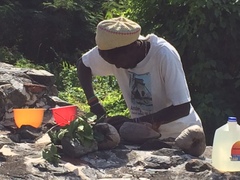 open a sugar cane stalk and gives us each a piece to chew on. On the hike back, Malachi says “Mom, this is the best adventure hike ever!”
open a sugar cane stalk and gives us each a piece to chew on. On the hike back, Malachi says “Mom, this is the best adventure hike ever!”

